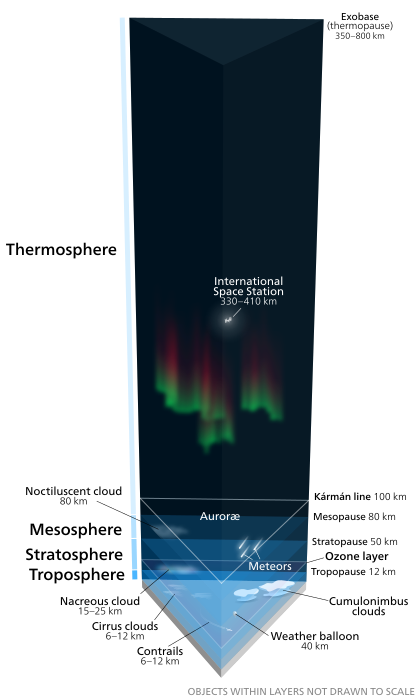Content of the atmosphere-air
Nitrogen
Oxygen
Argon
Carbon Dioxide
Neon
Helium
Methane
Krypton
Divisions of the atmosphere by temperature
Troposphere-Where most weather occurs, temperatures decrease throughout this layer. It is warmest near the ground because the ground absorbs what radiation that makes it to the surface and conducts it to the air near it. It is about 12 km thick.
Stratosphere-Ozone layer is here. Temperature rises as altitude increases because Ozone layer absorbs UV radiation and gives off heat.
Mesosphere-Temperature drops, lowest temperatures typically found here.
Thermosphere- Temperature rises because the incoming solar radiation is not filtered out and any particles it encounters will be highly energized.

O +Cl →ClO-
ClO-+O3 → 2O2+Cl
ClO-+O → O2+Cl
Humidity
Trends as air rises through the atmosphere
ELR vs DAR vs WAR
ELR is Environmental Lapse Rate This is the measured rate that the temperature of the atmospheric environment changes and varies from place to place between 5C/km and 10C/km.
DAR is Dry adiabatic Rate, the rate that rising unsaturated air cools, which is around 10C/km.
WAR is an organized and often prolonged conflict that is carried out by states or non-state actors. It is generally characterized by extreme violence, social disruption, and economic destruction....
Actually, it is the Wet adiabatic Rate, which is the rate rising saturated air cools. the rate is around 6C/km. the WAR is lower than the DAR because water condensing releases heat. So if the air parcel is saturated, it can no longer hold more moisture. But as it rises, the temp drops, allowing more water to condense, releasing more heat.
Unstable vs Stable air
Stable Air has a tendency to sink. The temperature of the air parcel is lower than the surroundings.
Unstable Air has a tendency to rise. The temperature of the air parcel is higher than the surroundings. rising unstable air forms convective clouds that form thunderstorms.
What do clouds need to form?
Water an condensation nuclei (particles for water to begin condensing onto; can be almost anything small enough)
Types of clouds (there are 11) by form and height
Precipitation formation, be familiar with both methods
Collision coalescence
Water vapor in the cloud collide with a nuclei, forming a water drop. This drop in turn collides with more water droplets, growing bigger and bigger until it falls out of the sky due to gravity as rain.
Bergeron Process-when cloud temps are below freezing
If you have any questions, please do not hesitate to ask using the comments.
Hope this helps,
-Alex
|
Tuesday, December 17, 2013
ESS Test Notes...
Monday, December 16, 2013
A dusting?
A clear night is expected early, follow by cloudiness and possibly up to a dusting of snow, as a clipper passes by. A clipper, AKA Alberta Clipper, is a low pressure system that originates out of Canada. they are usually moisture starved and carry very little snow by the time it gets here. Occasionally, the clipper transfers its energy offshore and bombs out, creating a snowstorm. One example is the second snowstorm of February 2010. As stated previously, these storms do not happen very often. 2 clippers are expected to pass in the next 2 days. One tomorrow morning and one tomorrow afternoon. The second one will be a little bit stronger but temps should be warm enough to limit any accumulations. After the clippers, a warming trend is expected with temps into the mid to upper 50's by the end of the week.
Subscribe to:
Comments (Atom)